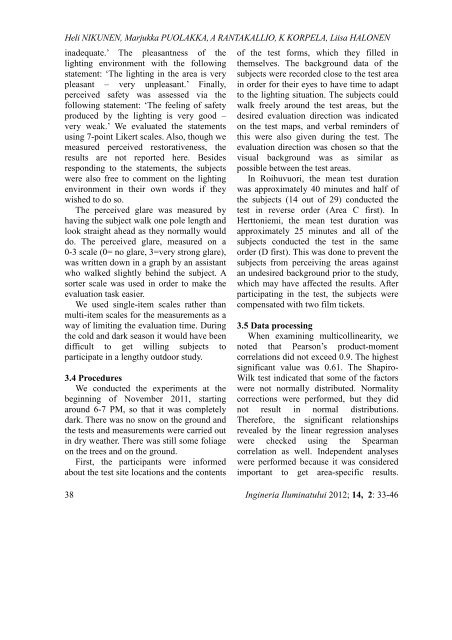Untitled - Journal of Lighting Engineering
Untitled - Journal of Lighting Engineering
Untitled - Journal of Lighting Engineering
You also want an ePaper? Increase the reach of your titles
YUMPU automatically turns print PDFs into web optimized ePapers that Google loves.
Heli NIKUNEN, Marjukka PUOLAKKA, A RANTAKALLIO, K KORPELA, Liisa HALONEN<br />
inadequate.’ The pleasantness <strong>of</strong> the<br />
lighting environment with the following<br />
statement: ‘The lighting in the area is very<br />
pleasant – very unpleasant.’ Finally,<br />
perceived safety was assessed via the<br />
following statement: ‘The feeling <strong>of</strong> safety<br />
produced by the lighting is very good –<br />
very weak.’ We evaluated the statements<br />
using 7-point Likert scales. Also, though we<br />
measured perceived restorativeness, the<br />
results are not reported here. Besides<br />
responding to the statements, the subjects<br />
were also free to comment on the lighting<br />
environment in their own words if they<br />
wished to do so.<br />
The perceived glare was measured by<br />
having the subject walk one pole length and<br />
look straight ahead as they normally would<br />
do. The perceived glare, measured on a<br />
0-3 scale (0= no glare, 3=very strong glare),<br />
was written down in a graph by an assistant<br />
who walked slightly behind the subject. A<br />
sorter scale was used in order to make the<br />
evaluation task easier.<br />
We used single-item scales rather than<br />
multi-item scales for the measurements as a<br />
way <strong>of</strong> limiting the evaluation time. During<br />
the cold and dark season it would have been<br />
difficult to get willing subjects to<br />
participate in a lengthy outdoor study.<br />
3.4 Procedures<br />
We conducted the experiments at the<br />
beginning <strong>of</strong> November 2011, starting<br />
around 6-7 PM, so that it was completely<br />
dark. There was no snow on the ground and<br />
the tests and measurements were carried out<br />
in dry weather. There was still some foliage<br />
on the trees and on the ground.<br />
First, the participants were informed<br />
about the test site locations and the contents<br />
38<br />
<strong>of</strong> the test forms, which they filled in<br />
themselves. The background data <strong>of</strong> the<br />
subjects were recorded close to the test area<br />
in order for their eyes to have time to adapt<br />
to the lighting situation. The subjects could<br />
walk freely around the test areas, but the<br />
desired evaluation direction was indicated<br />
on the test maps, and verbal reminders <strong>of</strong><br />
this were also given during the test. The<br />
evaluation direction was chosen so that the<br />
visual background was as similar as<br />
possible between the test areas.<br />
In Roihuvuori, the mean test duration<br />
was approximately 40 minutes and half <strong>of</strong><br />
the subjects (14 out <strong>of</strong> 29) conducted the<br />
test in reverse order (Area C first). In<br />
Herttoniemi, the mean test duration was<br />
approximately 25 minutes and all <strong>of</strong> the<br />
subjects conducted the test in the same<br />
order (D first). This was done to prevent the<br />
subjects from perceiving the areas against<br />
an undesired background prior to the study,<br />
which may have affected the results. After<br />
participating in the test, the subjects were<br />
compensated with two film tickets.<br />
3.5 Data processing<br />
When examining multicollinearity, we<br />
noted that Pearson’s product-moment<br />
correlations did not exceed 0.9. The highest<br />
significant value was 0.61. The Shapiro-<br />
Wilk test indicated that some <strong>of</strong> the factors<br />
were not normally distributed. Normality<br />
corrections were performed, but they did<br />
not result in normal distributions.<br />
Therefore, the significant relationships<br />
revealed by the linear regression analyses<br />
were checked using the Spearman<br />
correlation as well. Independent analyses<br />
were performed because it was considered<br />
important to get area-specific results.<br />
Ingineria Iluminatului 2012; 14, 2: 33-46
















